NCERT Solutions for Class 12 Maths Chapter 9 - Differential Equations - Miscellaneous Exercise
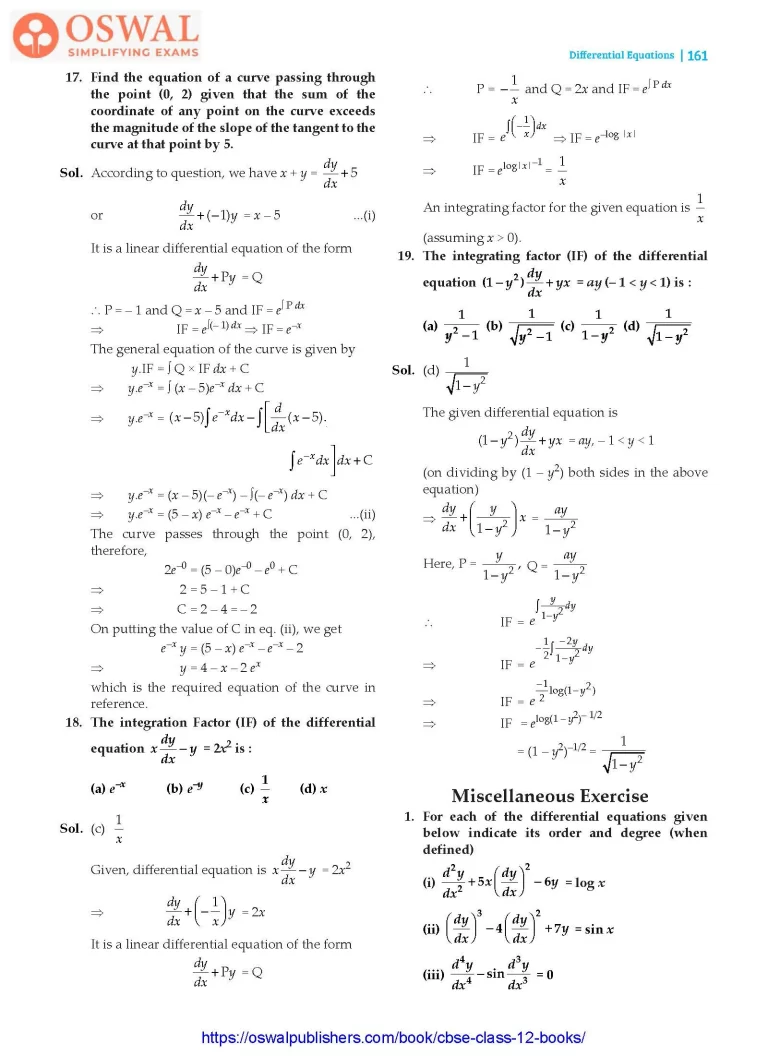
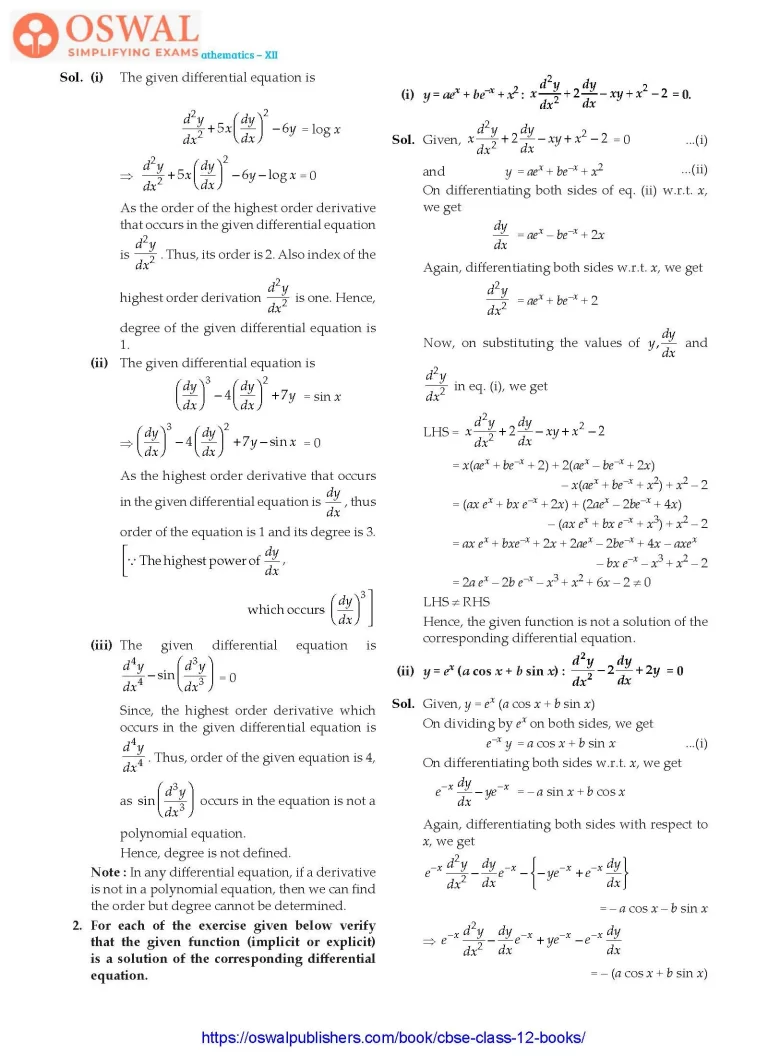
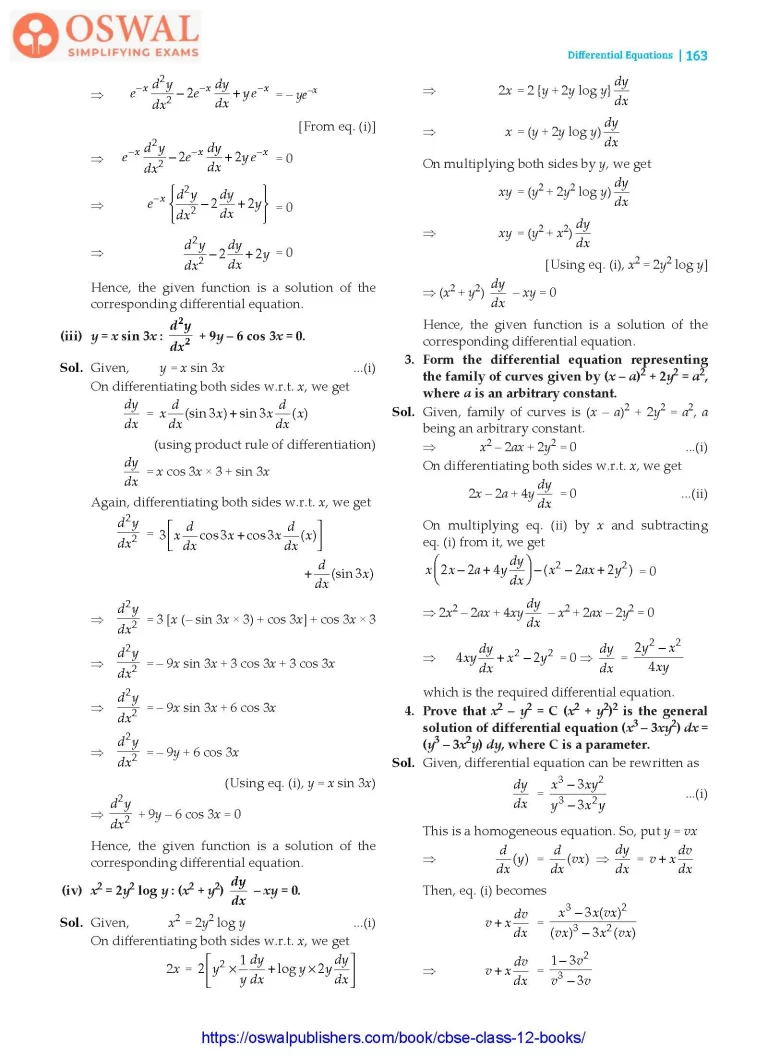
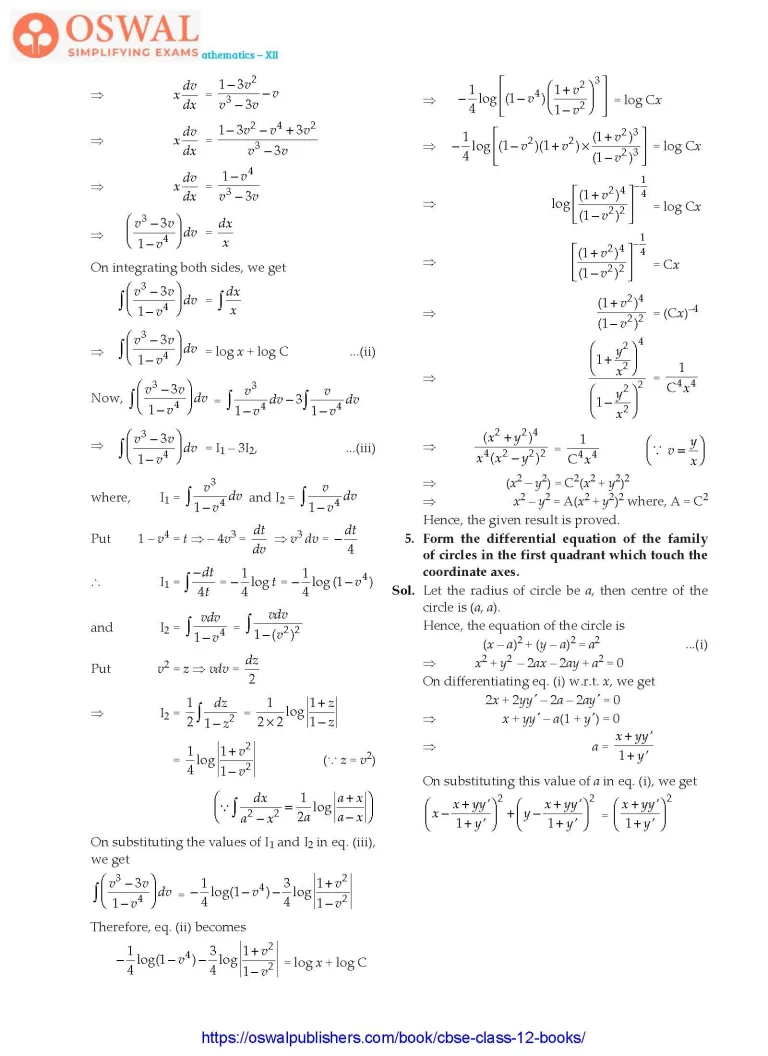
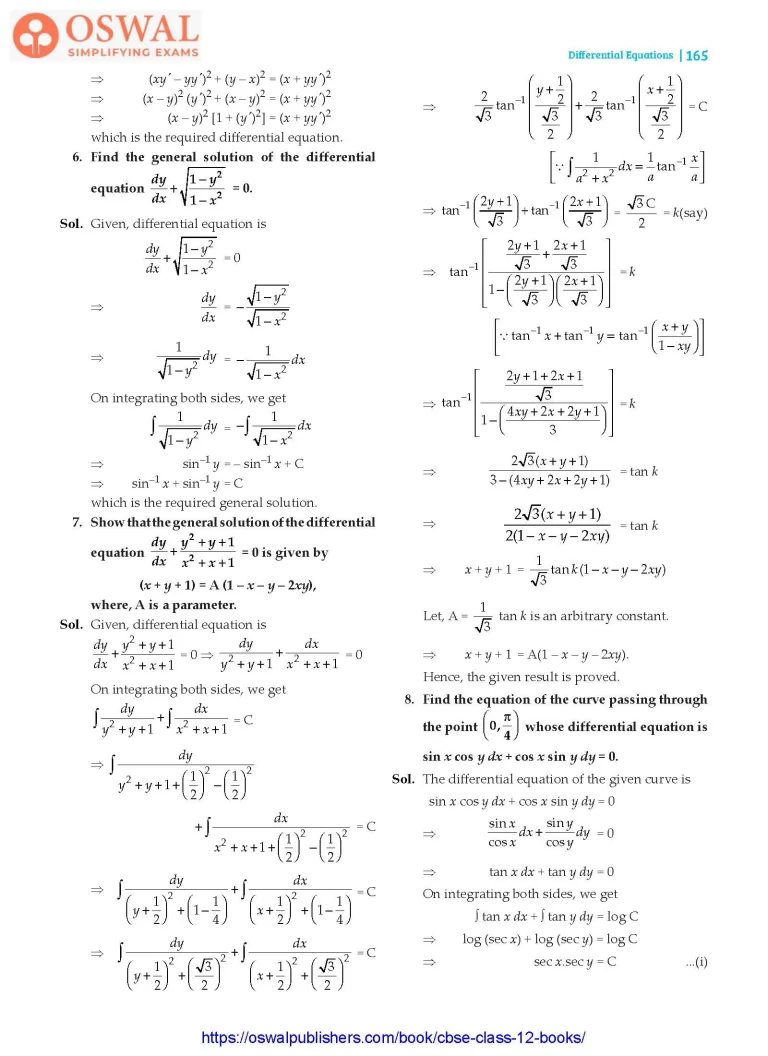
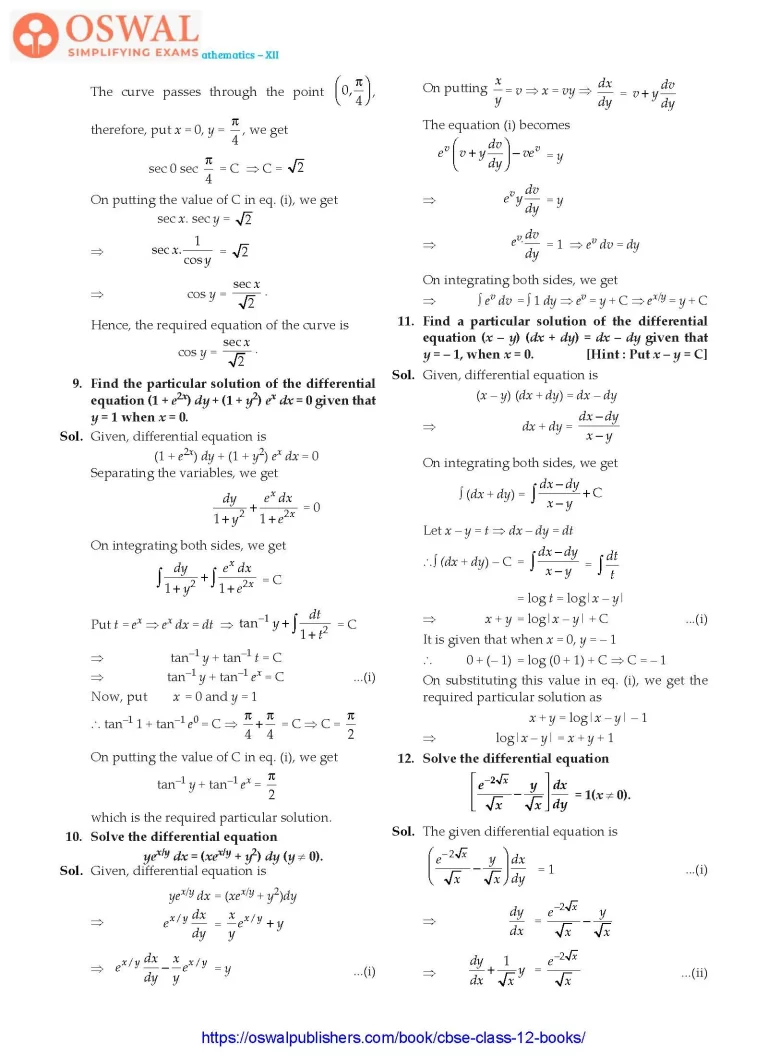
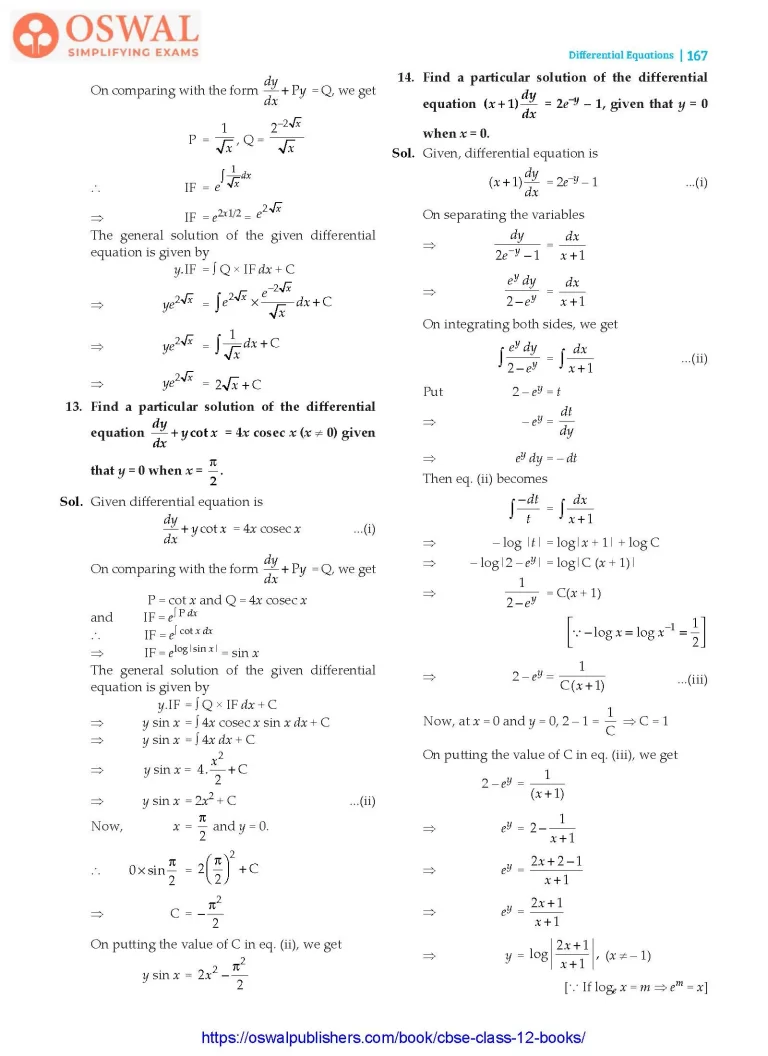
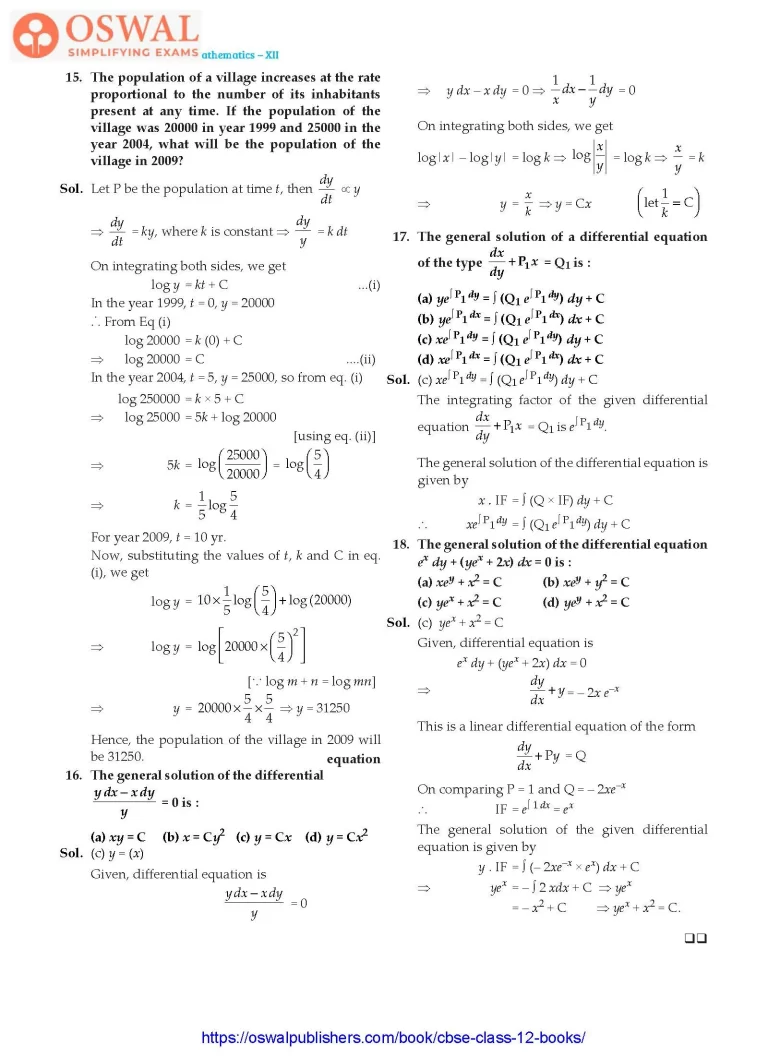
Access Exercises of Class 12 Maths Chapter 9 – Differential Equations
Exercise 9.1 Solutions 12 Questions
Exercise 9.2 Solutions 12 Questions
Exercise 9.3 Solutions 12 Questions
Exercise 9.4 Solutions 23 Questions
Exercise 9.5 Solutions 17 Questions
Exercise 9.6 Solutions 19 Questions
Miscellaneous Exercise on Chapter 9 Solutions 18 Questions
Miscellaneous Exercise
1. For each of the differential equations given below indicate its order and degree (when defined)
$$\textbf{(i)\space}\frac{\textbf{d}^{\textbf{2}}\textbf{y}}{\textbf{dx}^{\textbf{2}}} \textbf{+ 5x }\bigg(\frac{\textbf{dy}}{\textbf{dx}}\bigg)^{2}\textbf{- 6y = log x}\\\textbf{(ii)\space}\bigg(\frac{\textbf{dy}}{\textbf{dx}}\bigg)^{\textbf{3}} \textbf{- 4}\bigg(\frac{\textbf{dy}}{\textbf{dx}}\bigg)^{\textbf{2}} \textbf{+ 7y = sin x}\\\textbf{(iii)\space}\frac{\textbf{d}^{\textbf{4}}\textbf{y}}{\textbf{dx}^{4}} \textbf{- sin}\frac{\textbf{d}^{\textbf{3}}\textbf{y}}{\textbf{dx}^{\textbf{3}}} \textbf{= 0} $$
Sol. (i) The given differential equation is
$$\frac{d^{2}y}{dx^{2}} + 5x\bigg(\frac{dy}{dx}\bigg)^{2}\text{- 6y = log x}\\\Rarr\space \frac{d^{2}y}{dx^{2}} + 5x\bigg(\frac{dy}{dx}\bigg)^{2}\space\text{- 6y - log x = 0}$$
As the order of the highest order derivative that occurs in the given differential equation is
$$\frac{d^{2}y}{dx^{2}}.\space\text{Thus, its order is 2. Also index of the}\\\text{highest order derivation}\frac{d^{2}y}{dx^{2}}\space\text{is one.}$$
Hence, degree of the given differential equation is 1.
(ii) The given differential equation is
$$\bigg(\frac{dy}{dx}\bigg)^{3} - 4\bigg(\frac{dy}{dx}\bigg)^{2}+\\\text{ 7y = sin x}\\\Rarr\space \bigg(\frac{dy}{dx}\bigg)^{3}-4\bigg(\frac{dy}{dx}\bigg)^{2} + \\\text{7y - sin x = 0} $$
As the highest order derivative that occurs in the given differential equation is
$$\frac{dy}{dx},\space\text{thus order of the equation}\space\\\text{is 1 and its degree is 3.}\\\bigg[\because\space \text{The highest power of}\space\frac{dy}{dx},\\\text{which occurs}\bigg(\frac{dy}{dx}\bigg)^{3}\bigg]$$
(iii) The given differential equation is
$$\frac{d^{4}y}{dx^{4}}-\text{sin}\bigg(\frac{d^{3}y}{dx^{3}}\bigg)=0$$
Since, the highest order derivative which occurs in the given differential equation is
$$\frac{d^{4}y}{dx^{4}}.\space\text{Thus, order of the given equation}\\\text{is 4, as sin}\bigg(\frac{d^{3}y}{dx^{3}}\bigg)\space\text{occurs in the equation}\\\text{ is not a polynomial equation.}$$
Hence, degree is not defined.
Note : In any differential equation, if a derivative is not in a polynomial equation, then we can find the order but degree cannot be determined.
2. For each of the exercise given below verify that the given function (implicit or explicit) is a solution of the corresponding differential equation.
$$\textbf{(i)\space y = ae}^{\textbf{x}}\textbf{+ be}^{\normalsize-x} \textbf{+ x}^{\textbf{2}}:\\ \textbf{x}\frac{\textbf{d}^{\textbf{2}}\textbf{y}}{\textbf{dx}^{\textbf{2}}} \textbf{+ 2}\frac{\textbf{dy}}{\textbf{dx}} \textbf{- xy + x}^{\textbf{2}}\textbf{-2 = 0.}\\\textbf{Sol.}\space\text{Given,\space} x\frac{d^{2}y}{dx^{2}} + 2\frac{dy}{dx}\\-\text{xy + x}^{2} - 2 = 0\space\text{...(i)}$$
and y = aex + be–x + x2 ...(ii)
On differentiating both sides of eq. (ii) w.r.t. x, we get
$$\frac{dy}{dx} = ae^{x} - be^{\normalsize-x} + 2x$$
Again, differentiating both sides w.r.t. x, we get
$$\frac{d^{2}y}{dx^{2}} = ae^{x} + be^{\normalsize-x}+2$$
Now, on substituting the values of y
$$\frac{dy}{dx}\space\text{and}\space\frac{d^{2}y}{dx^{2}}\text{Now, on substituting}\\\text{ the values of y}\\\text{LHS = x}\frac{d^{2}y}{dx^{2}} + 2\frac{dy}{dx}-\\\text{xy + x}^{2}-2$$
= x(aex + be–x + 2) + 2(aex – be–x + 2x)
– x(aex + be–x + x2) + x2 – 2
= (ax ex + bx e–x + 2x) + (2aex – 2be–x + 4x)
– (ax ex + bx e–x + x3) + x2 – 2
= ax ex + bxe–x + 2x + 2aex – 2be–x + 4x – axex
– bx e–x – x3 + x2 – 2
= 2a ex – 2b e–x – x3 + x2 + 6x – 2 ≠ 0
LHS ≠ RHS
Hence, the given function is not a solution of the corresponding differential equation.
$$\textbf{(ii)\space y = e}^{\textbf{x}}\lbrace\textbf{a cos x + b sin x}\rbrace:\\\frac{\textbf{d}^{\textbf{2}}\textbf{y}}{\textbf{dx}^{\textbf{2}}}-2\frac{\textbf{dy}}{\textbf{dx}} \textbf{+ 2y = 0}$$
Sol. Given, y = ex (a cos x + b sin x)
On dividing by ex on both sides, we get
e–x y = a cos x + b sin x ...(i)
On differentiating both sides w.r.t. x, we get
$$e^{\normalsize-x}\frac{d^{2}y}{dx^{2}} - \frac{dy}{dx} e^{\normalsize-x} - \begin{Bmatrix}-ye^{\normalsize-x} + e^{\normalsize-x}\frac{dy}{dx}\end{Bmatrix}\\=\text{a cos x - b sin x}\\\Rarr\space e^{\normalsize-x}\frac{d^{2}y}{dx^{2}}-\frac{dy}{dx}e^{\normalsize-x} + ye^{\normalsize-x}\frac{dy}{dx}\\=-(\text{a cos x + b sin x})\\\Rarr\space e^{\normalsize-x}\frac{d^{2}y}{dx^{2}}-2e^{\normalsize-x}\frac{dy}{dx} + ye^{\normalsize-x} = -ye^{\normalsize-x}\\\lbrack\text{From eq. (i)}\rbrack\\\Rarr\space e^{\normalsize-x}\frac{d^{2}y}{dx^{2}}-2e^{\normalsize-x}\frac{dy}{dx} + 2ye^{\normalsize-x}= 0$$
$$\Rarr\space e^{\normalsize-x}\begin{Bmatrix}\frac{d^{2}y}{dx^{2}} -2\frac{dy}{dx} + 2y\end{Bmatrix} = 0\\\Rarr\space \frac{d^{2}y}{dx^{2}}-2\frac{dy}{dx}+2y =0$$
Hence, the given function is a solution of the corresponding differential equation.
$$\textbf{(iii)\space y = x sin 3x : }\frac{\textbf{d}^{\textbf{2}}\textbf{y}}{\textbf{dx}^{\textbf{2}}}\\\textbf{+ 9y - 6 cos 3x = 0.} $$
Sol. Given, y = x sin 3x ...(i)
On differentiating both sides w.r.t. x, we get
$$\frac{dy}{dx} = x \frac{dy}{dx}\text{(sin 3x) + sin 3x}\frac{d}{dx}(x)$$
(using product rule of differentiation)
$$\frac{dy}{dx} = \text{x\space cos 3x × 3} + \text{sin 3x}$$
Again, differentiating both sides w.r.t. x, we get
$$\frac{d^{2}y}{dx^{2}} = 3\bigg[x\frac{d}{dx}\text{cos 3x} + \text{cos 3x}\frac{d}{dx}(x)\bigg]\\ + \frac{d}{dx}(\text{sin 3x})\\\Rarr\space\frac{d^{2}y}{dx^{2}}=3[x(-\text{sin 3x×3}) + \text{cos 3x}]\\ \text{+ cos 3x × 3}\\\Rarr\space \frac{d^{2}y}{dx^{2}} =-9x \space \text{sin 3x + 3 cos 3x}+\\\text{3 cos 3x}\\\Rarr\space \frac{d^{2}y}{dx^{2}} =-\text{9x\space sin 3x + 6 cos 3x}\\\Rarr\space \frac{d^{2}y}{dx^{2}} =-9y + 6\space\text{cos 3x}$$
(Using eq. (i), y = x sin 3x)
$$\Rarr\space \frac{d^{2}y}{dx^{2}} + 9y - 6 cos 3x = 0$$
Hence, the given function is a solution of the corresponding differential equation.
$$\textbf{(iv)\space}\textbf{x}^{\textbf{2}} \textbf{- 2y}^{\textbf{2}}\space\textbf{log y} \textbf{:}\\\textbf{(x}^{\textbf{2}} \textbf{+ y}^{\textbf{2}})\frac{\textbf{dy}}{\textbf{dx}}\textbf{- xy = 0.}$$
Sol. Given, x2 = 2y2 log y ...(i)
On differentiating both sides w.r.t. x, we get
$$2x=2\bigg[y^{2}×\frac{1}{y}\frac{dy}{dx} + \text{log y×2y}\frac{dy}{dx}\bigg]\\\Rarr\space 2x=2\lbrace y + \text{2y log y}\rbrace\frac{dy}{dx}\\\Rarr\space \text{x =(y + 2y log y)}\frac{dy}{dx}$$
On multiplying both sides by y, we get
$$xy = (y^{2} + 2y^{2} \text{log y})\frac{dy}{dx}\\\Rarr\space xy = (y^{2}+x^{2})\frac{dy}{dx}\\\lbrack\text{Using eq. (i), x}^{2} = 2y^{2}\space\text{log y}\rbrack\\\Rarr\space (x^{2} +y^{2})\frac{dy}{dx}-xy = 0$$
Hence, the given function is a solution of the corresponding differential equation.
3. Form the differential equation representing the family of curves given by (x – a)2 + 2y2 = a2, where a is an arbitrary constant.
Sol. Given, family of curves is (x – a)2 + 2y2 = a2, a being an arbitrary constant.
$$\Rarr\space \text{x}^2 \text{– 2ax + 2y}^2 \text{= 0 ...(i)}$$
On differentiating both sides w.r.t. x, we get
$$\Rarr\space x^{2}-2ax + 4y\frac{dy}{dx} =0\space\text{...(ii)}$$
On multiplying eq. (ii) by x and subtracting eq. (i) from it, we get
$$x\bigg(2x-2a + 4y\frac{dy}{dx}\bigg) \\- (x^{2}-2ax + 2y^{2})=0\\\Rarr\space 2x^{2} - 2ax + 4xy\frac{dy}{dx}-\\x^{2} + 2ax - 2y^{2} = 0\\\Rarr 4xy\frac{dy}{dx} + x^{2} - 2y^{2}= 0\\\Rarr\space \frac{dy}{dx} = \frac{2y^{2} - x^{2}}{\text{4xy}}$$
which is the required differential equation.
4. Prove that x2 – y2 = C (x2 + y2)2 is the general solution of differential equation (x3 – 3xy2) dx = (y3 – 3x2y) dy, where C is a parameter.
Sol. Given, differential equation can be rewritten as
$$\frac{dy}{dx} = \frac{x^{3} - 3xy^{2}}{y^{3} - 3x^{2}y}\space\text{...(i)}$$
This is a homogeneous equation. So, put y = vx
$$\Rarr\space\frac{d}{dx}(y) = \frac{d}{dx}(vx)\\\Rarr\space \frac{dy}{dx} = v+x\frac{dv}{dx}$$
Then, eq. (i) becomes
$$\text{v + x}\frac{dv}{dx} = \frac{x^{3} - 3x(vx)^{2}}{(vx)^{3} - 3x^{2}(vx)}\\\Rarr\space\text{v+x}\frac{dv}{dx} = \frac{\text{1 - 3v}^{2}}{v^{3} - 3v}\\\Rarr\space x\frac{dv}{dx} = \frac{1 - 3v^{2}}{v^{3} - 3v}-v\\\Rarr\space x\frac{dv}{dx} = \frac{1 - 3v^{2}-v^{4} +3v^{2}}{v^{3} - 3v}\\\Rarr\space x\frac{dv}{dx} = \frac{1 - v^{4}}{v^{3}- 3v}\\\Rarr\space \bigg(\frac{v^{3} - 3v}{1 - v^{4}}\bigg)dv = \frac{dx}{x}$$
On integrating both sides, we get
$$\int\bigg(\frac{v^{3} - 3v}{1 - v^{4}}\bigg)dv = \int\frac{dx}{x}\\\Rarr\space\int\bigg(\frac{v^{3}-3v}{1 - v^{4}}\bigg)dv \\=\text{log x + log C}\space\text{...(ii)}\\\text{Now,\space}\int\bigg(\frac{v^{3}- 3v}{1- v^{4}}\bigg) dv = \\\int\frac{v^{3}}{\text{1-v}^{4}}dv - 3\int\frac{v}{\text{1 - v}^{4}}dv\\\Rarr\space \int\bigg(\frac{v^{3} - 3v}{\text{1- v}^{4}}\bigg)dv = \text{I}_1 - 3\text{I}_2\space\text{...(iii)}$$
$$\text{where,\space} \text{I}_1 = \int\frac{v^{3}}{\text{1 -v}^{4}}dv\space\text{and}\\\space\text{I}_2 = \int\frac{v}{\text{1 - v}^{4}}dv\\\text{Put 1 - v}^{4}= t\\\Rarr\space -4v^{3} =\frac{dt}{dv}\\\Rarr\space v^{3} dv= -\frac{dt}{4}\\\therefore\space \text{I}_1 =\int\frac{-dt}{4t} = -\frac{1}{4}\text{log t}\\=-\frac{1}{4}\text{log}(1-v^{4})$$
$$\text{and}\space\text{I}_2 = \int\frac{vdv}{\text{1 - v}^{4}} = \int\frac{vdv}{\text{1 - (v}^{2})^{2}}\\\text{Put v}^{2} = z\Rarr\space vdv=\frac{dz}{2}$$
$$\Rarr\space\text{I}_2 = \frac{1}{2}\int\frac{dz}{\text{1-z}^{2}} \\=\frac{1}{2×2}\text{log}\bigg|\frac{1+x}{1-x}\bigg|\\=\frac{1}{4}\text{log}\bigg|\frac{\text{1+v}^{2}}{\text{1-v}^{2}}\bigg|\space(\because z = v^{2})\\\bigg(\because\space \int\frac{dx}{a^{2}-x^{2}} = \frac{1}{2a}\text{log}\bigg|\frac{a+x}{a-x}\bigg|\bigg)$$
On substituting the values of I1 and I2 in eq. (iii), we get
$$\int\bigg(\frac{v^{3}-3v}{\text{1-v}^{4}}\bigg)dv = \frac{1}{4}\text{log}(1 - v^{4})-\\\frac{3}{4}\text{log}\bigg|\frac{\text{1 + v}^{2}}{1 - v^{2}}\bigg|$$
Therefore, eq. (ii) becomes
$$-\frac{1}{4}\text{log}(1 - v^{4})- \frac{3}{4}\text{log}\bigg|\frac{\text{1 + v}^{2}}{1-v^{2}}\bigg|\\=\text{log x + log C}\\\Rarr\space -\frac{1}{4}\text{log}\bigg[(1-v^{4})\bigg(\frac{1 + v^{2}}{1 - v^{2}}\bigg)\bigg]\\\text{= log Cx}\\\Rarr\space - \frac{1}{4}\text{log}\bigg[(1-v^{2})(1+v^{2})×\frac{(1 + v^{2})^{3}}{(1-v^{2})^{3}}\bigg]\\=\text{log Cx}$$
$$\Rarr\space\text{log}\bigg[\frac{(1 + v^{2})^{4}}{\text{(1-v}^{2})^{2}}\bigg] = \text{log Cx}\\\Rarr\space\bigg[\frac{(1 + v^{2})^{4}}{(1 - v^{2})^{2}}\bigg]^{\frac{1}{4}} = \text{Cx}\\\Rarr\space \frac{(1 + v^{2})^{4}}{(1 - v^{2})^{2}} = (\text{Cx})^{\normalsize-4}\\\Rarr\space \frac{\bigg(1 + \frac{y^{2}}{x^{2}}\bigg)^{4}}{\bigg(1- \frac{y^{2}}{x^{2}}\bigg)} = \frac{1}{C^{4}x^{4}}\\\Rarr\space \frac{(x^{2}+ y^{2})^{4}}{x^{4}(x^{2} - y^{2})^{2}} = \frac{1}{C^{4}x^{4}}$$
$$\bigg(\because\space v =\frac{y}{x}\bigg)\\\Rarr\space (x^{2}-y^{2}) = \text{C}^{2}(x^{2} + y^{2})^{2}\\\Rarr\space x^{2}-y^{2} = A(x^{2} + y^{2})^{2}\\\text{where, A = C}^{2}$$
Hence, the given result is proved.
5. Form the differential equation of the family of circles in the first quadrant which touch the coordinate axes.
Sol. Let the radius of circle be a, then centre of the circle is (a, a).
Hence, the equation of the circle is
(x – a)2 + (y – a)2 = a2 ...(i)
$$\Rarr\space x^{2} + y^{2} - 2ax - 2ay + a^{2} =0\space\text{...(i)} $$
On differentiating eq. (i) w.r.t. x, we get
2x + 2yy' – 2a – 2ay' = 0
$$\Rarr\space x + yy'-a(1 + y')= 0\\\Rarr\space a = \frac{x + yy'}{1 + y'}$$
On substituting this value of a in eq. (i), we get
$$\bigg(x - \frac{x + yy'}{1 + y'}\bigg)^{2} + \bigg(y- \frac{x + yy'}{1 + y'}\bigg)^{2}\\=\bigg(\frac{1 + yy'}{1 + y'}\bigg)^{2}$$
$$\Rarr\space (xy' - yy')^{2} + (y-x)^{2} = (x+yy')^{2}\\\Rarr\space (x-y)^{2}(y')^{2} + (x-y)^{2} = (x+yy')^{2}\\\Rarr\space (x-y)^{2}\lbrack 1 + (y')^{2}\rbrack = (x + yy')^{2}$$
which is the required differential equation.
6. Find the general solution of the differential equation
$$\frac{\textbf{dy}}{\textbf{dx}}+ \sqrt{\frac{\textbf{1 - y}^{\textbf{2}}}{\textbf{1 - x}^{\textbf{2}}}}\space\textbf{= 0.}$$
Sol. Given, differential equation is
$$\frac{dy}{dx} + \sqrt{\frac{\text{1 - y}^{2}}{\text{1-x}^{2}}} = 0\\\Rarr\space\frac{dy}{dx} = -\frac{\sqrt{1 - y^{2}}}{\sqrt{1 - x^{2}}}\\\Rarr\space \frac{1}{\sqrt{1 - y^{2}}}dy =-\frac{1}{\sqrt{1 - x^{2}}}dx$$
On integrating both sides, we get
$$\int\frac{1}{\sqrt{1 - y^{2}}}dy = -\int\frac{1}{\sqrt{1-x^{2}}}dx$$
$$\Rarr\space \text{sin}^{\normalsize-1}y =- \text{sin}^{\normalsize-1}x + \text{C}\\\Rarr\space\text{sin}^{-1}x + \text{sin}^{\normalsize-1}y = \text{C}$$
which is the required general solution.
7. Show that the general solution of the differential equation
$$\frac{\textbf{dy}}{\textbf{dx}} \textbf{+}\frac{\textbf{y}^{\textbf{2}} \textbf{+y+1}}{\textbf{x}^{\textbf{2}} \textbf{+ x + 1}} \textbf{= 0}\\\textbf{is given by} $$
(x + y + 1) = A (1 – x – y – 2xy),
where, A is a parameter.
Sol. Given, differential equation is
$$\frac{\text{dy}}{\text{dx}} \text{+} \frac{\text{y}^{\text{2}} \text{+ y + 1}}{\text{x}^{\text{2}} \text{+ x+ 1}} \text{= 0}\\\Rarr\space \frac{dy}{y^{2} + y+1} + \frac{dx}{x^{2} + x+1}=0$$
On integrating both sides, we get
$$\int\frac{dy}{y^{2} + y + 1} + \int\frac{dx}{x^{2} + x+1} \\=\text{C}\\\Rarr\space\int\frac{dy}{y^{2} + y+1 + \bigg(\frac{1}{2}\bigg)^{2} - \bigg(\frac{1}{2}\bigg)^{2}}+\\\int\frac{dx}{x^{2}+x+1+\bigg(\frac{1}{2}\bigg)^{2} - \bigg(\frac{1}{2}\bigg)^{2}}= \text{C}\\\Rarr\space \int\frac{dy}{\bigg(y +\frac{1}{2}\bigg)^{2} + \bigg(1- \frac{1}{2}\bigg)} +$$
$$\int\frac{dy}{y^{2} + y + 1} + \int\frac{dx}{x^{2} + x+1} \\=\text{C}\\\Rarr\space\int\frac{dy}{y^{2} + y+1 + \bigg(\frac{1}{2}\bigg)^{2} - \bigg(\frac{1}{2}\bigg)^{2}}+\\\int\frac{dx}{x^{2}+x+1+\bigg(\frac{1}{2}\bigg)^{2} - \bigg(\frac{1}{2}\bigg)^{2}}= \text{C}\\\Rarr\space \int\frac{dy}{\bigg(y +\frac{1}{2}\bigg)^{2} + \bigg(1- \frac{1}{4}\bigg)} +$$
$$\int\frac{dx}{\bigg(x + \frac{1}{2}\bigg)^{2} + \bigg(1 -\frac{1}{4}\bigg)} = \text{C}$$
$$\Rarr\space\int\frac{dy}{\bigg(y + \frac{1}{2}\bigg)^{2} + \bigg(\frac{\sqrt{3}}{2}\bigg)^{2}} +\\ \int\frac{dx}{\bigg(x + \frac{1}{2}\bigg)^{2} + \bigg(\frac{\sqrt{3}}{2}\bigg)^{2}} =\text{C}$$
$$\Rarr\space\frac{2}{\sqrt{3}}\text{tan}^{\normalsize-1}\bigg(\frac{y + \frac{1}{2}}{\frac{\sqrt{3}}{2}}\bigg) + \\\frac{2}{\sqrt{3}}\text{tan}^{\normalsize-1}\bigg(\frac{x + \frac{1}{2}}{\frac{\sqrt{3}}{2}}\bigg) =\text{C}\\\bigg[\because\space \int\frac{1}{a^{2} + x^{2}}dx = \frac{1}{a}\text{tan}^{\normalsize-1}\frac{x}{a}\bigg]\\\Rarr\space\text{tan}^{\normalsize-1}\bigg(\frac{2y+1}{\sqrt{3}}\bigg) + \\\text{tan}^{\normalsize-1}\bigg(\frac{2x+1}{\sqrt{3}}\bigg) =\frac{\sqrt{3}\text{C}}{2}\\\text{ = k (say)}$$
$$\Rarr\space\text{tan}^{\normalsize-1}\bigg[\frac{\frac{2y+1}{\sqrt{3}} + \frac{2x+1}{\sqrt{3}}}{1 -\bigg(\frac{2y+1}{\sqrt{3}}\bigg)\bigg(\frac{2x+1}{\sqrt{3}}\bigg)}\bigg] = k\\\bigg[\because\space \text{tan}^{-1}x + \text{tan}^{-1}y = \text{tan}^{\normalsize-1}\bigg(\frac{x+y}{1 - xy}\bigg)\bigg]$$
$$\Rarr\space \text{tan}^{\normalsize-1}\begin{bmatrix}\frac{\frac{\normalsize2y\normalsize+1\normalsize+2x\normalsize+1}{\sqrt{\normalsize3}}}{1 -\bigg(\frac{\normalsize4xy \normalsize+ 2x \normalsize+2y\normalsize+1}{\normalsize3}\bigg)}\end{bmatrix}=\text{k}$$
$$\Rarr\space\frac{2\sqrt{3}(x+y+1)}{3 -(4xy + 2x + 2y+1)}=\text{tan k}\\\Rarr\space \frac{2\sqrt{3}(x+y+1)}{2(1-x-y-2xy)} =\text{tan k}\\\Rarr\space x+y+1 \\= \frac{1}{\sqrt{3}}\text{tan k}(1 -x- y-2xy)$$
$$\text{Let A =}\frac{1}{\sqrt{3}}\space\text{tan k is an}\\ \text{arbitrary constant.}\\\Rarr\space x+y+1=A(1-x-y-2xy).$$
Hence, the given result is proved.
8. Find the equation of the curve passing through the point
$$\bigg(\textbf{0,}\frac{\pi}{\textbf{4}}\bigg)\space\textbf{whose differential equation is}$$
sin x cos y dx + cos x sin y dy = 0.
Sol. The differential equation of the given curve is
sin x cos y dx + cos x sin y dy = 0
$$\Rarr\space\frac{\text{sin x}}{\text{cos x}}dx + \frac{\text{sin y}}{\text{cos y}}dy =0\\\Rarr\space\text{tan x dx + tan y dy = 0}$$
On integrating both sides, we get
$$\int\space\text{tan x dx} + \int\text{tan y dy} = \text{log C}\\\Rarr\space\text{log (sec x) + log (sec y) = log C}\\\Rarr\space\text{sec x.sec y = C}\space\text{...(i)}$$
The curve passes through the point
$$\bigg(0,\frac{\pi}{4}\bigg),\space\text{therefore, put x=0, y=}\frac{\pi}{4},\\\text{we get}\\\text{sec 0 sec}\frac{\pi}{4} =\text{C}\\\Rarr\text{C} = \sqrt{2}$$
On putting the value of C in eq. (i), we get
$$\text{sec x.sec y} = \sqrt{2}\\\Rarr\space\text{sec x}.\frac{1}{\text{cos y}}= \sqrt{2}\\\Rarr\space \text{cos y = }\frac{\text{sec x}}{\sqrt{2}}$$
Hence, the required equation of the curve is
$$\text{cos y} =\frac{\text{sec x}}{\sqrt{2}}.$$
9. Find the particular solution of the differential equation (1 + e2x) dy + (1 + y2) ex dx = 0 given that y = 1 when x = 0.
Sol. Given, differential equation is
(1 + e2x) dy + (1 + y2) ex dx = 0
Separating the variables, we get
$$\frac{dy}{1 + y^{2}} + \frac{e^{x}dx}{1 + e^{2x}} =0$$
On integrating both sides, we get
$$\int\frac{dy}{\text{1 + y}^{2}} + \int\frac{e^{x}dx}{\text{1 + e}^{2x}} =\text{C}\\\text{Put t = e}^x\\\Rarr\space e^{x}dx = dt\\\Rarr\space\text{tan}^{\normalsize-1}y + \int\frac{dt}{1 + t^{2}} = \text{C}\\\Rarr\space \text{tan}^{\normalsize-1}y + \text{tan}^{\normalsize-1}t =\text{C}\\\Rarr\space\text{tan}^{\normalsize-1}y + \text{tan}^{\normalsize-1} e^{x} = \text{C}\space\text{...(i)} $$
Now, put x = 0 and y = 1
$$\therefore\space \text{tan}^{\normalsize-1} + \text{tan}^{\normalsize-1}\space e^{0}\\\Rarr\space\frac{\pi}{4} + \frac{\pi}{4} = \text{C}\\\Rarr\space\text{C = }\frac{\pi}{2}$$
On putting the value of C in eq. (i), we get
$$\text{tan}^{\normalsize-1}y + \text{tan}^{\normalsize-1}e^{x} = \frac{\pi}{2}$$
which is the required particular solution.
10. Solve the differential equation
$$\textbf{ye}^{\frac{\textbf{x}}{\textbf{y}}}\textbf{dx = (xe}^{\frac{\textbf{x}}{\textbf{y}} }\textbf{+ y}^{\textbf{2}}\textbf{) dy(y}\neq \textbf{0).}$$
Sol. Given, differential equation is
$$ye^{\frac{x}{y}}dx = (xe^{\frac{x}{y}} +y^{2})dy\\\Rarr\space e^{\frac{x}{y}}\frac{dx}{dy} = \frac{x}{y}e^{\frac{x}{y}}+y\\\Rarr\space e^{\frac{x}{y}}\frac{dx}{dy}-\frac{x}{y}e^{\frac{x}{y}} = y\space\text{...(i)}\\\text{On putting}\space\frac{x}{y}= v\\\Rarr\space x = vy\\\Rarr\space \frac{dx}{dy} = v + y\frac{dv}{dy}$$
The equation (i) becomes
$$e^{v}\bigg(v + y\frac{dv}{dy}\bigg)-ve^{v} = y\\\Rarr\space e^{v}y\frac{dv}{dy} = y\\\Rarr\space e^{v}\frac{dv}{dy} =1\\\Rarr\space e^v dv = dy$$
On integrating both sides, we get
$$\Rarr\int e^vdv = \int 1\space dy\\\Rarr e^v = \text{y + C}\\\Rarr\space e^{\frac{x}{y}} = \text{y + C}$$
11. Find a particular solution of the differential equation (x – y) (dx + dy) = dx – dy given that y = – 1, when x = 0.
[Hint : Put x – y = C]
Sol. Given, differential equation is
(x – y) (dx + dy) = dx – dy
$$\Rarr\space dx + dy = \frac{\text{dx-dy}}{\text{x-y}}$$
On integrating both sides, we get
$$\int(dx + dy) = \int\frac{dx - dy}{x-y}+ \text{C}\\\text{Let x-y = t}\\\Rarr\space dx-dy = dt\\\therefore\int(dx+dy)-\text{C} =\\ \int\frac{dx-dy}{x-y} =\int\frac{dt}{t}$$
= log t = log|x – y|
$$\Rarr\space\text{x+y = log}|x-y| + \text{C}\\\space\text{...(i)}$$
It is given that when x = 0, y = – 1
$$\therefore\space 0 + (\normalsize-1) = \text{log}(0+1)+\text{C}\\\Rarr\space \text{C = -1}$$
On substituting this value in eq. (i), we get the required particular solution as
x + y = log|x – y| – 1
$$\Rarr\space \text{log}|x-y| = x+y+1$$
12. Solve the differential equation
$$\bigg[\frac{\textbf{e}^{\normalsize\textbf{-2}\sqrt{\textbf{x}}}}{\sqrt{\textbf{x}}} - \frac{\textbf{y}}{\sqrt{\textbf{x}}}\bigg]\frac{\textbf{dx}}{\textbf{dy}}\textbf{=1(x}\neq\textbf{0).}$$
Sol. The given differential equation is
$$\bigg(\frac{e^{2\sqrt{x}}}{\sqrt{x}} - \frac{y}{\sqrt{x}}\bigg)\frac{dx}{dy}=1\\\Rarr\space\frac{dx}{dy} = \frac{e^{-2\sqrt{x}}}{\sqrt{x}}- \frac{y}{x}\\\Rarr\space \frac{dy}{dx} + \frac{1}{\sqrt{x}}y =\frac{e^{-2\sqrt{x}}}{\sqrt{x}}\space\text{...(ii)}\\\text{On comparing with the form}\\\frac{dy}{dx} +\text{Py = Q,}\\\text{we get}\\\text{P =}\frac{1}{\sqrt{x}},\text{Q} = \frac{2^{-2\sqrt{x}}}{\sqrt{x}}$$
$$\therefore\space\text{IF = e}^{\int\frac{1}{\sqrt{x}}dx}\\\Rarr\space \text{IF = e}^{2x1/2} = e^{2\sqrt{x}}$$
The general solution of the given differential equation is given by
$$y.\text{IF} = \int Q × \text{IF}\space dx + \text{C}\\\Rarr\space ye^{2\sqrt{x}} = \int e^{2\sqrt{x}}×\frac{e^{-2\sqrt{x}}}{\sqrt{x}}dx + \text{C}\\\Rarr\space ye^{2\sqrt{x}} =\int\frac{1}{x}\text{dx + C}\\\Rarr\space ye^{2\sqrt{x}} = 2\sqrt{x} + \text{C}$$
13. Find a particular solution of the differential equation
$$\frac{\textbf{dy}}{\textbf{dx}} \textbf{+ y cot x = 4x cosec x(x}\neq\textbf{0)}\\\textbf{given that y=0 when x=}\frac{\pi}{\textbf{2}}\textbf{.}$$
Sol. Given differential equation is
$$\frac{dy}{dx} + y\space\text{cot x = 4x cosec x}\space\\\text{...(i)}\\\text{On comparing with the form}\\\frac{dy}{dx} + \text{Py = Q,}\space\text{we get}$$
P = cot x and Q = 4x cosec x
$$\text{and\space}\text{IF = e}^{\int\text{P dx}}\\\therefore\space\text{IF = e}^{\int\text{cot x dx}}\\\Rarr\space \text{IF = e}^{\text{log}|\text{sin x}|} = \text{sin x}$$
The general solution of the given differential equation is given by
$$\text{y.IF} = \int Q ×\text{IF dx + C}\\\Rarr\space \text{y sin x =}\\\int 4x\space \text{cosec x sinx dx + C}\\\Rarr\space\text{y sin x} =\int4x\space dx + \text{C}\\\Rarr\space\text{y sin x = 4.}\frac{x^{2}}{2} + \text{C}\\\Rarr\space\text{y sin x = 2x}^{2}\text{+ C}\space\text{...(ii)}\\\text{Now,\space x =}\frac{\pi}{2}\text{and y = 0.}\\\therefore\space 0×\text{sin}\frac{\pi}{2} = 2\bigg(\frac{\pi}{2}\bigg)^{2} + \text{C}$$
$$\Rarr\space\text{C = }-\frac{\pi^{2}}{2}$$
On putting the value of C in eq. (ii), we get
$$\text{y sin x = 2x}^{2} -\frac{\pi^{2}}{2}$$
14. Find a particular solution of the differential equation
$$\textbf{(x+1)}\frac{\textbf{dy}}{\textbf{dx}} \textbf{= 2e}^{\textbf{-y}}\textbf{-1,}$$
given that y = 0 when x = 0.
Sol. Given, differential equation is
$$(x+1)\frac{dy}{dx} = 2e^{\normalsize-y}-1\space\text{...(i)}$$
On separating the variables
$$\Rarr\space \frac{dy}{2e^{\normalsize-y}-1} = \frac{dx}{x+1}\\\Rarr\space \frac{e^{y} dy}{2-e^{y}} = \frac{dx}{x+1}$$
On integrating both sides, we get
$$\int\frac{e^{y}dy}{2-e^{y}} =\int\frac{dx}{x+1}\space\text{...(ii)}\\\text{Put 2 - e}^{y}=t\\\Rarr\space -e^{y} = \frac{dt}{dy}\\\Rarr\space e^{y}\space dy =- dt$$
Then eq. (ii) becomes
$$\int\frac{-dt}{t} = \int\frac{dx}{x+1}\\\Rarr\space -\text{log}|t| = \text{log}|x+1|+\\\text{log C}\\\Rarr\space -\text{log}|2 - e^{y}| = \text{log}|\text{C(x+1)}|\\\Rarr\space \frac{1}{\text{2 - e}^{y}} =\text{C}(x+1)\\\bigg[\because\space -\text{log x = log x}^{\normalsize-1} = \frac{1}{2}\bigg]\\\Rarr\space 2-e^{y} = \frac{1}{\text{C}(x+1)}\space\text{...(iii)}\\\text{Now, at x = 0 and y = 0, 2 – 1 }\\=\frac{1}{C}\Rarr\space\text{C = 1}$$
On putting the value of C in eq. (iii), we get
$$2 - e^{y}= \frac{1}{(x +1)}\\\Rarr\space e^{y} = 2-\frac{1}{x+1}\\\Rarr\space e^{y} = \frac{2x+2-1}{x+1}\\\Rarr\space e^{y}= \frac{2x+1}{x+1}\\\Rarr\space\text{y = log}\bigg|\frac{2x+1}{x+1}\bigg|, (x \neq-1)\\\lbrack\because\space \text{If log}_e x = m\Rarr\space e^{m} = x\rbrack$$
15. The population of a village increases at the rate proportional to the number of its inhabitants present at any time. If the population of the village was 20000 in year 1999 and 25000 in the year 2004, what will be the population of the village in 2009?
Sol. Let P be the population at time t,
$$\text{then\space}\frac{dy}{dt}\propto y\\\Rarr\space \frac{dy}{dt} = ky,\space\text{where k is constant}\\\Rarr\frac{dy}{y} = k\space dt$$
On integrating both sides, we get
log y = kt + C ...(i)
In the year 1999, t = 0, y = 20000
∴ From Eq (i)
log 20000 = k (0) + C
$$\Rarr\space \text{log}\space 20000 = \text{C}\space\text{...(ii)}$$
In the year 2004, t = 5, y = 25000, so from eq. (i)
log 250000 = k × 5 + C
$$\Rarr\space\text{log 25000 = 5k + log 20000}\\\lbrack\text{using eq. (ii)}\rbrack\\\Rarr\space 5k = \text{log}\bigg(\frac{25000}{20000}\bigg) = \text{log}\bigg(\frac{5}{4}\bigg)\\\Rarr\space k = \frac{1}{5}\text{log}\frac{5}{4}$$
For year 2009, t = 10 yr.
Now, substituting the values of t, k and C in eq. (i), we get
$$\text{log y = 10×}\frac{1}{5}\text{log}\bigg(\frac{5}{4}\bigg)+\\\text{log(20000)}\\\Rarr\space \text{log y = log}\bigg[20000×\bigg(\frac{5}{4}\bigg)^{2}\bigg]\\\lbrack\because\space\text{log m + n = log mn}\rbrack\\\Rarr\space y = 20000×\frac{5}{4}×\frac{5}{4}\\\Rarr\space y = 31250$$
Hence, the population of the village in 2009 will be 31250.
16. The general solution of the differential equation
$$\frac{\textbf{ydx - xdy}}{\textbf{y}} \textbf{= 0}\space\textbf{is:}$$
(a) xy = C
(b) x = Cy2
(c) y = Cx
(d) y = Cx2
Sol. (c) y = (x)
Given, differential equation is
$$\frac{\text{ydx - xdy}}{\text{y}} \text{= 0}$$
$$\Rarr\space y dx- xdy=0\\\Rarr\space \frac{1}{x}dx-\frac{1}{y}dy=0$$
On integrating both sides, we get
log|x| – log|y| = log k
$$\Rarr\space \text{log}\bigg|\frac{x}{y}\bigg| =\text{log K}\\\Rarr\space \frac{x}{y} = k\\\Rarr\space y = \frac{x}{k}\Rarr\space y = \text{Cx}\\\bigg(\text{let}\frac{1}{k} =\text{C}\bigg)$$
17. The general solution of a differential equation of the type
$$\frac{\textbf{dx}}{\textbf{dy}} \textbf{+} \textbf{P}_\textbf{1}\textbf{x = Q}_\textbf{1}\space\textbf{is :}$$
$$\textbf{(a)\space ye}^{\int \textbf{P}_\textbf{1} \textbf{dy}} = \int(\textbf{Q}_\textbf{1}\textbf{e}^{\int\textbf{P}_\textbf{1}\textbf{dy}})\textbf{dy + C}\\\textbf{(b)\space}\textbf{ye}^{\int\textbf{P}_\textbf{1}\textbf{dx}} = \int(\textbf{Q}_1 \textbf{e}^{\int\textbf{P}_\textbf{1}\textbf{dx}})\textbf{dx + C}\\\textbf{(C)\space xe}^{\int\textbf{P}_\textbf{1}\textbf{dy}} = \int(\textbf{Q}_1\textbf{e}^{\int \textbf{P}_\textbf{1} \textbf{dy}}) \textbf{dy + C}\\\textbf{(d)\space xe}^{\int\textbf{P}_\textbf{1}\textbf{dx}} = \int(\textbf{Q}_\textbf{1}\textbf{e}^{\int\textbf{P}_\textbf{1}\textbf{dx}})\textbf{dx + C}$$
$$\textbf{Sol.\space}(c)\space xe^{\int\text{P}_1 dy} = \int(Q_1e^{\int\text{P}_1dy})dy + \text{C}$$
The integrating factor of the given differential equation
$$\frac{dx}{dy} + \text{P}_1x = Q_1\space\text{is}\space e^{\int\text{P}_1 dy}.$$
The general solution of the differential equation is given by
$$x\space.\space\text{IF} = \int\text{(Q×IF) dy +} \text{C}\\\therefore\space xe^{\int\text{P}_1 dy} = \int(Q_1 e^{\int\text{P}_1dy})dy + \text{C}$$
18. The general solution of the differential equation ex dy + (yex + 2x) dx = 0 is :
(a) xey + x2 = C
(b) xey + y2 = C
(c) yex + x2 = C
(d) yey + x2 = C
Sol. (c) yex + x2 = C
Given, differential equation is
ex dy + (yex + 2x) dx = 0
$$\Rarr\space\frac{dy}{dx} + y =-2x e^{\normalsize-x}$$
This is a linear differential equation of the form
$$\frac{dy}{dx} + \text{Py = Q}$$
On comparing P = 1 and Q = – 2xe –x
$$\therefore\space \text{IF = e}^{\int \text{1}\space \textbf{dx}} = e^{x}$$
The general solution of the given differential equation is given by
y . IF = ∫ (– 2xe–x × ex) dx + C
$$\Rarr\space ye^{x}=-\int 2x\space dx +\text{C}\Rarr\space ye^{x}\\= -x^{2} + \text{C}\\\Rarr\space ye^{x} + x^{2} = \text{C.}$$
